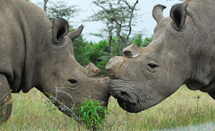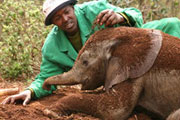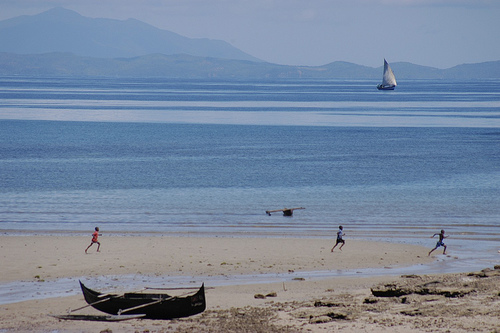Comprehensive Guide to Gorilla Trekking in Africa: All you need to know
It is no surprise that gorilla trekking in Africa makes it onto the top 10 of many a traveler's bucket list. Seeing mountain gorillas in the wild is one of the most incredible wildlife encounters on earth!
 Isaro's baby gorilla by Kwita Izina Mountain gorillas are critically endangered, which makes the life-changing experience of visiting them in their natural habitat even more extraordinary and precious. There are said to be just over 1060 African mountain gorillas left in the wild (as of late 2019). The rare chance to see a family of gorillas in pristine rainforest habitat is not only one of the ultimate wildlife experiences in Africa, but it is also a once-in-a-lifetime expedition that sadly may not be possible in the future.
Isaro's baby gorilla by Kwita Izina Mountain gorillas are critically endangered, which makes the life-changing experience of visiting them in their natural habitat even more extraordinary and precious. There are said to be just over 1060 African mountain gorillas left in the wild (as of late 2019). The rare chance to see a family of gorillas in pristine rainforest habitat is not only one of the ultimate wildlife experiences in Africa, but it is also a once-in-a-lifetime expedition that sadly may not be possible in the future.
Article Quick Links
- Best Places for Gorilla Trekking in Africa
- In Uganda - Bwindi Forest & Mgahinga National Parks
- In Rwanda - Volcanoes National Park
- In the DRC - Virunga National Park
- Which Country is Best for Gorilla Trekking?
- A Typical Gorilla Trek - How it Works
- Why Go Gorilla Trekking in Uganda?
- Do's & Don'ts - Gorilla Trekking Rules
- Tips for Your Gorilla Trek
- Buying Gorilla Trekking Permits
- When to Go Gorilla Trekking in Africa
 Gorilla Trekking in Africa by Hjalmar Gislason
Gorilla Trekking in Africa by Hjalmar Gislason
Where are the Best Places to go Gorilla Trekking in Africa?
 Mountain Gorillas in Africa by Martijn.MunnekeThe main countries where you can go gorilla trekking in Africa are Uganda, Rwanda, and the Democratic Republic of Congo (DRC). The natural environment of these mountain gorillas (Gorilla beringei beringei) is dense rainforest and more specifically the moist tropical and subtropical forests of the Albertine Rift in central Africa.
Mountain Gorillas in Africa by Martijn.MunnekeThe main countries where you can go gorilla trekking in Africa are Uganda, Rwanda, and the Democratic Republic of Congo (DRC). The natural environment of these mountain gorillas (Gorilla beringei beringei) is dense rainforest and more specifically the moist tropical and subtropical forests of the Albertine Rift in central Africa.
African mountain gorillas currently inhabit two forested mountain areas: the Bwindi Impenetrable Forest (Uganda) and the Virunga Mountain region (Rwanda, Uganda, and DRC).
The 4 national parks where gorilla trekking takes place in the region:
- Bwindi Impenetrable National Park in southwestern Uganda
- Mgahinga Gorilla National Park in the far southwest of Uganda
- Volcanoes National Park in northern Rwanda
- Virunga National Park in the eastern region of the DRC
Gorilla Trekking in Uganda - Bwindi Forest Park & Mgahinga National Park
Southern Uganda hosts 13 gorilla groups in Bwindi Impenetrable National Park, and two families in Mgahinga Gorilla National Park - conveniently located next door to Bwindi. The groups inhabiting the southern part of Uganda, in Bwindi Impenetrable Forest National Park, are:
- Rushaga Sector: Kutu (20), Bikingi (12), Busingye (9), Bweza (15), Kahungye (25), Mishaya (8), and Shongi (11).Mubare, and Habiyanja.
- Nkuringo Sector: Bushaho (10), and Nkuringo (12).
- Ruhija Sector: Bitukura (13), Oruzogo (10), Kyaguliro (4), and Mukiza (15).
- Buhoma Sector: Habinyanja (12), Rushegura (19), Katwe (9), and the oldest habituated group in Bwindi Mubare (9).
Mgahinga National Park hosts two family groups of gorillas, Hirwa (13 members) and Nyakagezi (9 members). In the past, the Nyakagezi group has been free-roaming and moves between Rwanda, Uganda, and the DRC. The family group consists of 9 gorillas, including four silverback males, 2 adult females, 1 juvenile, and 2 infants.
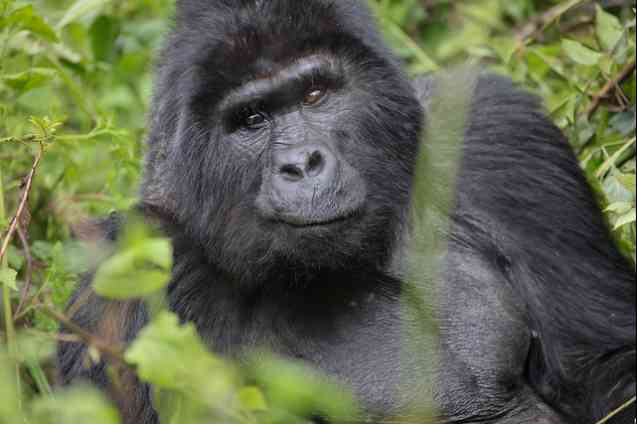 Bwindi Gorilla trekking, Uganda by Andrea Schieber
Bwindi Gorilla trekking, Uganda by Andrea Schieber
Bwindi Impenetrable National Park is a UNESCO World Heritage Site, located in south-western Uganda. Bwindi shelters about half of the wild mountain gorilla population (about 400) remaining in the world today. The national park covers about 331km² of thick montane and lowland rainforest habitat.
 Silver and young gorilla by Cristoffer CrusellThe Mgahinga Gorilla National Park is located in the far southwestern part of Uganda, bordering Rwanda (Volcanoes National Park)and the DRC (Virunga National Park). This is the Ugandan gorilla territory that falls in the Virunga Volcanoes region, which spans all three central African countries. The Mgahinga Gorilla National Park is Uganda's smallest national park (about 34 km²) forming part of the larger Virunga Conservation Area, which incorporates some 434 km² of volcanic mountains. This compact park is home to two gorilla families, one of which is free-roaming. The result is that these families are much less predictable, and so less reliably tracked.
Silver and young gorilla by Cristoffer CrusellThe Mgahinga Gorilla National Park is located in the far southwestern part of Uganda, bordering Rwanda (Volcanoes National Park)and the DRC (Virunga National Park). This is the Ugandan gorilla territory that falls in the Virunga Volcanoes region, which spans all three central African countries. The Mgahinga Gorilla National Park is Uganda's smallest national park (about 34 km²) forming part of the larger Virunga Conservation Area, which incorporates some 434 km² of volcanic mountains. This compact park is home to two gorilla families, one of which is free-roaming. The result is that these families are much less predictable, and so less reliably tracked.
The national parks in Uganda are managed by the Uganda Wildlife Authority (UWA).
Getting to Bwindi & Mgahinga Gorilla National Park in Uganda
 Uganda Scenery by misssharongray It takes more than a day to drive southwest to Mgahinga Gorilla National Park and Bwindi Impenetrable Park (over 12 hours on rough roads) from Kampala. The drive gives you a good idea of what rural Uganda looks like and passes through some beautiful scenery in parts. Alternatively, you can take a short flight from Entebbe (an international airport near Kampala) to Kisoro or by charter to Kayonza Airstrip, both near Bwindi. Once at Bwindi, this ancient and biodiverse forest can only be accessed on foot.
Uganda Scenery by misssharongray It takes more than a day to drive southwest to Mgahinga Gorilla National Park and Bwindi Impenetrable Park (over 12 hours on rough roads) from Kampala. The drive gives you a good idea of what rural Uganda looks like and passes through some beautiful scenery in parts. Alternatively, you can take a short flight from Entebbe (an international airport near Kampala) to Kisoro or by charter to Kayonza Airstrip, both near Bwindi. Once at Bwindi, this ancient and biodiverse forest can only be accessed on foot.
One of the easiest and most affordable ways to visit Bwindi Park is on a guided gorilla trekking tour starting in Kampala (serviced by the nearby Entebbe International Airport). Compare our Uganda Gorilla Trekking Tours by browsing our upcoming tours departing from Kampala.
Gorilla Trekking in Rwanda - Volcanoes National Park
Volcanoes National Park covers about 125 km² of incredibly scenic forest-covered mountains, as well as six extinct volcanoes, including Mt. Karisimbe, at 4,507 m is the highest volcano in the Virungas.
 Silverback gorilla in Africa by Kate
Silverback gorilla in Africa by Kate
Just over half of the world's remaining mountain gorillas (about 604 according to WWF) are found in the broader Virunga Conservation Area (Virunga Mountains), which includes the well-managed Volcanoes National Park in Rwanda. This is where the legendary and iconic gorilla conservationist, Dian Fossey, lived and worked with gorillas. The gorillas here are more habituated than in other areas, meaning that they are more accustomed to having humans around. There are seven gorilla families that can be visited in Volcanoes National Park.
 Rwanda Gorilla baby & mom by Kate Gorilla trekking in Rwanda is slightly less strenuous than in Bwindi National Park because the gorillas move around less. The open terrain amid bamboo forests also allows more light into the environment, making for better photo opportunities than in the heavily forested Bwindi. The gorilla trekking procedure in Rwanda is slightly different from that in Uganda. In Uganda, you purchase gorilla permits for a given gorilla family and then trek to that family, but in Rwanda, the permit is not specific to a family, and the gorilla group you are allocated is dependent on several factors. After being briefed on gorilla trekking, visitors are split into groups according to age, fitness level, and the location of the gorilla families at the time.
Rwanda Gorilla baby & mom by Kate Gorilla trekking in Rwanda is slightly less strenuous than in Bwindi National Park because the gorillas move around less. The open terrain amid bamboo forests also allows more light into the environment, making for better photo opportunities than in the heavily forested Bwindi. The gorilla trekking procedure in Rwanda is slightly different from that in Uganda. In Uganda, you purchase gorilla permits for a given gorilla family and then trek to that family, but in Rwanda, the permit is not specific to a family, and the gorilla group you are allocated is dependent on several factors. After being briefed on gorilla trekking, visitors are split into groups according to age, fitness level, and the location of the gorilla families at the time.
Getting to Volcanoes National Park in Rwanda
 Volcanoes, Rwanda by John Cooke Volcanoes National Park is located in northern Rwanda, about 80 km from the capital, Kigali. Getting to the Volcanoes Park in northern Rwanda is quicker and easier than getting to Bwindi in Uganda. About two and a half hours drive from Kigali, if you're traveling on a tight budget you can catch a mini-bus taxi to Ruhengeri town, situated at the park entrance, or you can catch a taxi.
Volcanoes, Rwanda by John Cooke Volcanoes National Park is located in northern Rwanda, about 80 km from the capital, Kigali. Getting to the Volcanoes Park in northern Rwanda is quicker and easier than getting to Bwindi in Uganda. About two and a half hours drive from Kigali, if you're traveling on a tight budget you can catch a mini-bus taxi to Ruhengeri town, situated at the park entrance, or you can catch a taxi.
For budget gorilla trekking tours to Volcanoes Park, see our upcoming tours departing from Kigali.
Gorilla Trekking in the DRC - Virunga National Park
In the Democratic Republic of Congo (DRC) mountain gorillas are found in the Virunga National Park, a UNESCO World Heritage Site. Located in eastern DRC this national park borders Uganda and Rwanda.
 Virunga National Park by Heather ThorkelsonThe 7800 km² Virunga National Park is home to about 200 gorillas, living mostly in the southern areas of the park. The national park is managed by the Congolese National Park Authorities, together with the Institut Congolais pour la Conservation de la Nature (ICCN) and its partner the Africa Conservation Fund. After a decline in numbers about seven years ago, due to brutal attacks in which at least 10 gorillas were killed, the gorilla population has recovered somewhat. The population is more stable now, largely thanks to the brave efforts of rangers risking their lives in Virunga National Park. Virunga is also home to the Senkwekwe Centre, the world’s only facility for orphaned mountain gorillas.
Virunga National Park by Heather ThorkelsonThe 7800 km² Virunga National Park is home to about 200 gorillas, living mostly in the southern areas of the park. The national park is managed by the Congolese National Park Authorities, together with the Institut Congolais pour la Conservation de la Nature (ICCN) and its partner the Africa Conservation Fund. After a decline in numbers about seven years ago, due to brutal attacks in which at least 10 gorillas were killed, the gorilla population has recovered somewhat. The population is more stable now, largely thanks to the brave efforts of rangers risking their lives in Virunga National Park. Virunga is also home to the Senkwekwe Centre, the world’s only facility for orphaned mountain gorillas.
The national park is 32 km west of Goma, the capital of North Kivu province. Transport from Goma to the park can easily be arranged with the Virunga National Park. The roads are in bad condition and it's best to go with someone who knows the area or to join a guided tour, as the tourism infrastructure is not as developed as in Rwanda and Uganda. The best way to reach Goma is from neighboring Rwanda, traveling on well-maintained roads from Kigali. It takes about three hours to reach the DRC border near Goma, from Kigali. The border crossing is unproblematic and from there, it's a short walk (10 minutes) to Goma. You can also get to Goma and Virunga from southwestern Uganda, making the relatively easy border crossing at Bunagana, where an affordable local visa can be purchased.
Virunga faces major threats from Mai Mai Militias and frequently loses rangers to unprovoked attacks. The situation is carefully monitored and at times visiting Virunga is not possible. For up-to-date information and ways that you can contribute, you can visit the Virunga website.
Uganda, Rwanda, or DRC - Where's Best?
 Male gorilla on gorilla trek by Philip KromerThe exact location of the African mountain gorillas living in the Virunga Volcanoes region shifts as the great apes move between the forests of Uganda, Rwanda, and the DRC. Many of the well-informed tour operators in the region, typically select the area for gorilla trekking expeditions based on the given location of the gorilla populations at the time of the trip. Thus, you usually find yourself tracking gorillas in either Rwanda or Uganda, the two more popular destinations.
Male gorilla on gorilla trek by Philip KromerThe exact location of the African mountain gorillas living in the Virunga Volcanoes region shifts as the great apes move between the forests of Uganda, Rwanda, and the DRC. Many of the well-informed tour operators in the region, typically select the area for gorilla trekking expeditions based on the given location of the gorilla populations at the time of the trip. Thus, you usually find yourself tracking gorillas in either Rwanda or Uganda, the two more popular destinations.
Pricing Differences
The downside of choosing Rwanda is that the gorilla permit costs more - US$ 1500 as opposed to US$ 700 in Uganda, and US$ 450 at Virunga in the DRC. In terms of costs, similar tours in Uganda and Rwanda are quite competitively priced, so you can find a good deal in either country. That said, you can probably get a better safari deal in Uganda. The upside of trekking in Rwanda is that it's quick and easy, given the proximity of the international airport in Kigali to Volcanoes National Park (116 km).
Uganda - cheaper permits, more to see & do
The major advantage of trekking in Uganda is that it is cheaper in terms of gorilla permits and you can combine gorilla trekking with other highlights. A gorilla trekking safari can include spending time at beautiful Lake Bunyonyi close to Bwindi, game viewing in Queen Elizabeth National Park and chimpanzee trekking in Kibale National Park. That said, Akagera National Park in Rwanda is now a Big 5 destination and offers some excellent safari game viewing opportunities.
Driving Distances & Getting to the Gorillas
The longer distance to and from Bwindi Forest Park and the international airport in Entebbe (just outside Kampala) add to your traveling costs on the Uganda side. The drive is further in Uganda, but it is scenic and offers insight into rural Africa. The short drive in Rwanda is on the other hand not particularly scenic or interesting. If the long drive is an issue, then you can fly from Entebbe to Bwindi, landing in the nearby towns of Kihihi and Kisoro. There are some affordable flights around, with AeroLink Uganda.
Trekking to the Gorillas
In Uganda, the gorillas tend to be found deeper in the forest in groups of between 10 and 20, with at least one silverback (alpha male). The trekking itself is generally more challenging in Bwindi (Uganda) given that the gorillas are more tucked away and after viewing the gorillas you often have to ascend steep slopes out of the forests.
In Rwanda, some of the gorilla families are often found closer to the park entrance, requiring a shorter hike and are therefore easier to access. Family groups range between 9 and 39 gorillas including at least one silverback. You cannot, however, request which gorilla groups you want to see and the location of the groups does shift further into the forests.
 DRC Gorilla by Joe McKenna
DRC Gorilla by Joe McKenna
Political Considerations
Other important factors to consider when deciding where to go gorilla trekking, include the local political conditions in these three countries and the availability of the gorilla permits.
Uganda
Uganda is a safe and stable country, having rebuilt itself after decades of conflict and unrest. Travel to the southwestern part of the country is secure and Uganda is generally a peaceful nation making it an excellent choice for gorilla tracking safaris.
Rwanda
Rwanda is politically stable, having recovered from the genocide that took place almost 30 years ago. The Volcanoes National Park can be visited safely, is well managed, and has a permit system that is functioning efficiently. Rwanda is safe and considered an excellent gorilla-tracking safari destination
The DRC
Virunga National Park suffers from ongoing conflict with Mai Mai Militias, an unfortunate consequence of years of political unrest. It is imperative that you check, and monitor the situation at the time of your travels, the Virunga website is excellent. Some travel advisory organizations consider the area too volatile for travel and recommend avoiding the DRC at present (UK government's foreign travel advisory). That said, people who do take the risk often have incredible, trouble-free trips, but this is not for everyone.
A Typical Mountain Gorilla Trek - How it Works
Tracking down rare gorillas in the thick rainforests of central Africa is not an exact science.
How to Find the Gorillas
 African Gorilla look by Hjalmar Gislason Finding and getting to the gorillas is not always easy, nor are you guaranteed to see them. The arduous trek to the gorilla groups takes you through very dense vegetation, on narrow trails lined with stinging nettles, and up steep and often muddy slopes. The search for gorillas can last several hours since the gorillas move around in the thick undergrowth shifting deeper into the forests at times. The good news is that not only will you have an experienced guide to lead the way, but the gorilla families are habituated to human visitors, and will not pay very much attention to you at all.
African Gorilla look by Hjalmar Gislason Finding and getting to the gorillas is not always easy, nor are you guaranteed to see them. The arduous trek to the gorilla groups takes you through very dense vegetation, on narrow trails lined with stinging nettles, and up steep and often muddy slopes. The search for gorillas can last several hours since the gorillas move around in the thick undergrowth shifting deeper into the forests at times. The good news is that not only will you have an experienced guide to lead the way, but the gorilla families are habituated to human visitors, and will not pay very much attention to you at all.
Starting your Gorilla Trekking Expedition
Trekking expeditions start out early in the morning, driving to the boundary of the national park for formalities before continuing to a ranger's station.
 Hidden Gorilla on trek by Martijn.Munneke Leaving your wheels behind at the ranger station, the walk begins. Your group follows a local ranger through farmlands and into the thick vegetation of Bwindi Impenetrable Forest.
Hidden Gorilla on trek by Martijn.Munneke Leaving your wheels behind at the ranger station, the walk begins. Your group follows a local ranger through farmlands and into the thick vegetation of Bwindi Impenetrable Forest.
Know Your Gorilla Whoop!
Did you know the collective noun for gorillas is a 'whoop'? The rangers can tell you about the specific family of gorillas you are trekking to, filling you in on the family history and sharing their in-depth knowledge about mountain gorillas.
The rangers usually trek to the site where the gorillas were seen the previous day and trace their movements from there to locate them. The gorillas are monitored daily which helps keep track of their locale, as well as their health and safety. After a fair amount of time, anything from 45 minutes to 8 hours of challenging bundu bashing along muddy tracks, you will hopefully come face-to-face with a family group of gorillas in the forest. Usually, you put your stuff down, try to remain silent, and move in a little closer with just your cameras. Note that rangers are trained to not get closer than about 7 meters to the gorillas.
The Gorilla Encounter
 Gorilla Trekking by Martijn.Munneke This is where the magic happens, as the unique and intimate gorilla encounter unfolds. You have an hour to observe and take pictures of these gentle apes in their natural state. Watching the untamed gorillas feed, groom, parent, play, and interact is spell-binding. The striking resemblance between the way the gorillas behave and relate with one another and the mannerisms of humans leaves many onlookers awestruck.
Gorilla Trekking by Martijn.Munneke This is where the magic happens, as the unique and intimate gorilla encounter unfolds. You have an hour to observe and take pictures of these gentle apes in their natural state. Watching the untamed gorillas feed, groom, parent, play, and interact is spell-binding. The striking resemblance between the way the gorillas behave and relate with one another and the mannerisms of humans leaves many onlookers awestruck.
Heading Back to Base
 African Gorillas by Ludovic Hirlimann After spending an hour with the gorilla family it is time to retrace your steps, trekking back to the ranger's station. Along the way to or back from the gorillas the group usually pauses to eat. You generally carry your own packed lunch and water along with you. Back at the starting point of the trek you transfer to your vehicle and make your way back to your accommodation.
African Gorillas by Ludovic Hirlimann After spending an hour with the gorilla family it is time to retrace your steps, trekking back to the ranger's station. Along the way to or back from the gorillas the group usually pauses to eat. You generally carry your own packed lunch and water along with you. Back at the starting point of the trek you transfer to your vehicle and make your way back to your accommodation.
Gorilla Tracking Experiences May Vary
 Gorilla eating on gorilla trek by Hjalmar GislasonThe above is a rough guide to what will take place on the ground. The actual experience can vary depending on local conditions (weather, gorilla movements, and happenings, politics, etc.), as well as being slightly different between exact locations and tour operators. It is important to remember that the gorillas are wild, which means that even though they are habituated to humans, their behavior is somewhat unpredictable.
Gorilla eating on gorilla trek by Hjalmar GislasonThe above is a rough guide to what will take place on the ground. The actual experience can vary depending on local conditions (weather, gorilla movements, and happenings, politics, etc.), as well as being slightly different between exact locations and tour operators. It is important to remember that the gorillas are wild, which means that even though they are habituated to humans, their behavior is somewhat unpredictable.
The gorillas may possibly retreat into the bush while you are visiting them which is beyond your rangers' control as their movements are not restricted. The gorillas generally go about their activities undisturbed though, with some of the young ones showing curiosity about the human visitors.
Why go Gorilla Trekking in Uganda?
 Thinking gorilla, Africa by Guido da Rozze The “Pearl of Africa”, Uganda is a scenic country of lush landscapes, abundant wildlife, flowing rivers, still lakes and towering mountains covered in dense rainforests. Uganda is known for its friendly people and is a relatively safe place to travel. Uganda offers excellent game viewing, unique cultural exchanges, and chimpanzee trekking in addition to the main drawcard of gorilla trekking, making it a well-rounded safari destination.
Thinking gorilla, Africa by Guido da Rozze The “Pearl of Africa”, Uganda is a scenic country of lush landscapes, abundant wildlife, flowing rivers, still lakes and towering mountains covered in dense rainforests. Uganda is known for its friendly people and is a relatively safe place to travel. Uganda offers excellent game viewing, unique cultural exchanges, and chimpanzee trekking in addition to the main drawcard of gorilla trekking, making it a well-rounded safari destination.
The main tourist attraction is, of course, the gorilla population in Bwindi Impenetrable Forest National Park, but Uganda is also home to a healthy population of chimpanzees, drawing visitors to Kibale National Park to trek to these smaller primates. The Queen Elizabeth National Park is also a top-notch game-viewing destination inhabited by a variety of game and birds.
 Gorilla trek Africa by Guido da Rozze The gorilla trekking industry in Uganda is well-established, having started in the early '90s, and is benefiting local communities. The gorilla populations are stable, even growing in recent years, thanks to effective national park management and concerted conservation efforts. In Bwindi Forest itself, there are also walking trails to soak up the spectacular views, visit waterfalls, and enjoy bird watching. Visitors can also explore local villages, like Buhoma, to meet the local people and get a taste of life in rural Uganda.
Gorilla trek Africa by Guido da Rozze The gorilla trekking industry in Uganda is well-established, having started in the early '90s, and is benefiting local communities. The gorilla populations are stable, even growing in recent years, thanks to effective national park management and concerted conservation efforts. In Bwindi Forest itself, there are also walking trails to soak up the spectacular views, visit waterfalls, and enjoy bird watching. Visitors can also explore local villages, like Buhoma, to meet the local people and get a taste of life in rural Uganda.
Some Gorilla Trekking Regulations
 Mountain gorilla sitting by Martijn.Munneke Gorilla encounter regulations include maximum group size, the number of groups allowed to track per day, and time allowed with them - all of which are to ensure the well-being of the critically endangered gorillas. Gorillas are highly susceptible to human diseases given how closely related we are to these apes (2% genetic difference).
Mountain gorilla sitting by Martijn.Munneke Gorilla encounter regulations include maximum group size, the number of groups allowed to track per day, and time allowed with them - all of which are to ensure the well-being of the critically endangered gorillas. Gorillas are highly susceptible to human diseases given how closely related we are to these apes (2% genetic difference).
- Small groups - a maximum of eight people are permitted per group per day to reduce disturbance and limit exposure to human diseases.
- Visiting hours - trekking takes place during daylight hours, between about 8:00 a.m. and 7:00 p.m. (seasonal).
- Age restriction - 15 or 16 years and over only.
- Time limit - one hour with the gorillas.
Do's & Don'ts of Gorilla Trekking - the rules
- Listen to your guide - your gorilla trekking guide will brief you before your experience begins. Pay careful attention and help them to keep you AND the gorillas safe.
- Protect the gorillas - if you are sick or have any infectious diseases, DO NOT GO. If you don't feel well, you need to sit this one out to safeguard the well-being of these endangered animals. One sick gorilla could decimate an entire family.
- Remember your manners - if you cough or sneeze turn away and cover your nose and mouth to reduce the chances of transmitting bacteria or viruses to the primates.
- Don't overstay your welcome - expect to spend only the allotted one hour with the gorillas, departing when the time is up.
- Keep your distance - stay at least 5-7 meters (21 feet) away from the gorillas, not because they are dangerous but because they are wild and we can transmit diseases to them.
- Behave yourself - keep the noise levels down (from within 200 m), don't point, and don't use your flash when taking photographs.
- Go prepared - take warm and waterproof gear for the cool mountain conditions in these often wet forests and wear comfortable walking shoes.
- No snacking and smoking - you are not allowed to eat, drink, or smoke around the gorillas.
- Clean up - wash your hands before going gorilla trekking.
- Keep your hands to yourself - You may not touch the gorillas even if they come close to you as these curious apes sometimes do.
- Hang onto your trash - don't litter.
- Remain calm - if a gorilla charges, do not run away. Crouch down slowly and avoid direct eye contact, until the gorilla moves off.
- Toilet etiquette - if you need to go then ask your guide to dig a hole in the forest and make sure it gets covered up afterwards.
 Troop of gorillas in the willd by Philip Kromer
Troop of gorillas in the willd by Philip Kromer
Tips for Your Gorilla Trek
- Keep yourself covered - long pants, gaiters, and socks help keep the bugs (red ants) at bay and gloves will protect you from stinging nettles and thorny branches.
- Get reasonably fit - the trek is usually a physically challenging and tiring mission through rough terrain, so you want to be relatively fit to make the journey as pleasant as possible.
- Be equipped - carry enough water, waterproof bags for your camera, and insect repellent as well as sunscreen and a hat.
- Stay warm and dry - take warm and rainproof clothing with you to cope with the cold conditions at altitude.
- Join an organized trip - book through a tour company to simplify your travels and get the gorilla permits arranged for you beforehand.
- Choose your timing - try to avoid trekking in the rainy season (March to April and October to November) when the going gets tougher.
- Book well in advance - Gorilla tracking is popular and permits are limited, book in advance to avoid disappointment.
Buying Gorilla Trekking Permits
 Volcanoes gorilla trekking by Derek Keats Every visitor needs an official permit to go gorilla trekking in any of the national parks. The gorilla trekking activities are closely regulated and the permits are expensive. Permits should be arranged well in advance, which is one of the reasons why most people go through tour companies. For gorilla treks, the high season (June to September and late November to February) bookings need to be made several months in advance (at least five).
Volcanoes gorilla trekking by Derek Keats Every visitor needs an official permit to go gorilla trekking in any of the national parks. The gorilla trekking activities are closely regulated and the permits are expensive. Permits should be arranged well in advance, which is one of the reasons why most people go through tour companies. For gorilla treks, the high season (June to September and late November to February) bookings need to be made several months in advance (at least five).
Ugandan Gorilla Trekking Permits
The gorilla permit costs about US$ 700 per person, for one day in high season. In the low season (April, May, and November) permit prices can sometimes drop so check with us.
How & where to buy permits
Permits can be purchased in cash or with traveler's cheques at the Uganda Wildlife Authority (UWA) central office in Kampala or from abroad. If you want to get a permit in Kampala remember that availability is limited, especially in the high season, thus advanced booking is highly recommended. In the low season, you can sometimes get the permit on the spot at the UWA headquarters.
Buying Permits Online
For the online route, direct bookings are made via email and can be paid for by transfer (EFT), but they don't take credit card payments. You can buy permits as far as two years ahead of time, putting down a 30% deposit and paying the balance 91 days before your trek.
Local tour operators are given the first option on the bulk of the gorilla permits (80%) up to two years in advance, which can then be sold to foreign tour operators or visitors at US$ 50 - 100 more to cover logistics.
You can only buy permits issued by the Uganda Wildlife Authority either directly to you or via an authorized tour company selling the permit for the original price.
Rwandan Trekking Permits
In Rwanda, you can get permits through the Rwanda Tourism Board offices (ORTPN) in Kigali or Ruhengeri (near the PNV). You can call or email them directly, but it is tricky to get just the permit and not a whole tour package. The permits cost about USD 1500 per person per day and most people get permits through a gorilla trekking tour operator. Early booking is strongly advised, even more than four months in advance during peak season (June to October).
 Rwanda gorilla trek by Derek Keats
Rwanda gorilla trek by Derek Keats
DRC Trekking Permits
If you plan to go gorilla trekking in the DRC it is best to book a tour with one of the reputable operators, who then get you a permit (US$ 450).
When to Go Gorilla Trekking in Africa
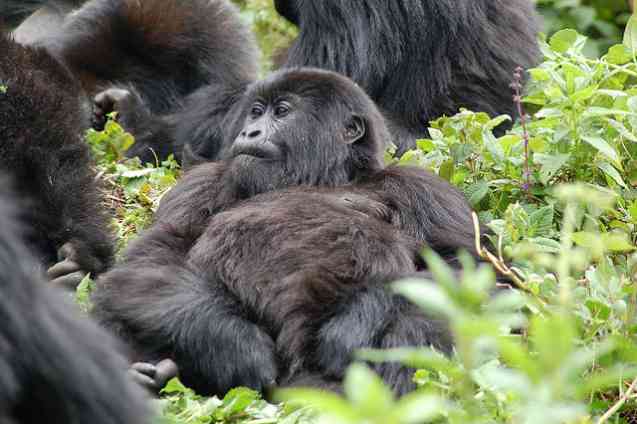 Gorilla Troop, Africa by Joachim Huber
Gorilla Troop, Africa by Joachim Huber
You can hike to gorillas at any time of the year, although the paths are more difficult to navigate in the rainy season. The rainy seasons are March to April / May and October to November. For greater chances of sunshine and for hot weather, visit Uganda, Rwanda, or DRC from mid-December to late February or June to late September during the dry seasons.
Combine Gorilla Trekking in Rwanda & Uganda
You can now combine gorilla trekking in Rwanda and Uganda to enjoy the best of both Volcanoes and Bwindi on one trip! Browse our Gorilla Trekking Tours for budget-friendly trips to both gorilla hotspots.
For a firsthand travel account, see this fantastic post on trekking mountain gorillas written by avid traveler Johnny Africa, about our 7-day Gorilla Trekking Camping Safari in Uganda.
In Rwanda You can't, however, request which gorilla groups you want to see and the location of the groups does shift further into the forests.
[Last updated in September 2023]
If you liked this post, these trips cover similar ground…
- 3 Day Uganda Gorilla Trekking Safari
- 4 Day Uganda Gorilla Trekking & Wildlife Safari
- 8 Day Uganda Safari: Gorilla Trekking & Queen Elizabeth National Park
- 4 Day Uganda Gorilla Trekking Tour
- 6 Day Uganda Gorilla Trekking, Chimpanzee & Wildlife Safari
- 5 Day Uganda Gorillas & Wildlife Lodge Safari
- 15 Day Kenya Masai Mara & Uganda Gorilla Safari (Africa Tour Overland)
- 8 Day Uganda Gorilla Safari from Kampala (Lodge Overland Tour)
- 37 Day Gorillas & Kenya to Victoria Falls Safari - Overland Camping Tour
- Uganda Gorillas, Chimps & Wildlife Lodge Safari
- 13 Day Uganda Safari & Gorilla Trekking Tour
- 10 Day Uganda to Rwanda Gorillas & Wildlife Tour
- Rwanda Gorillas, Wildlife & Cultural Tour
- Rwanda Gorilla Trekking & Primate Tracking Tour
- 3 Day Uganda Gorillas Experience in Bwindi Forest Park
- 6 Day Uganda & Rwanda Gorilla Trekking Safari


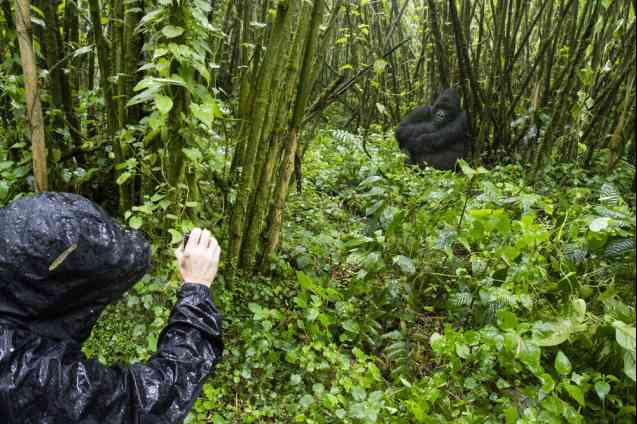
 Landia is a nature and animal lover. This South African woman avoids crowds seeking out quiet places. She has worked in the African safari industry for over 16 years!
Landia is a nature and animal lover. This South African woman avoids crowds seeking out quiet places. She has worked in the African safari industry for over 16 years!




